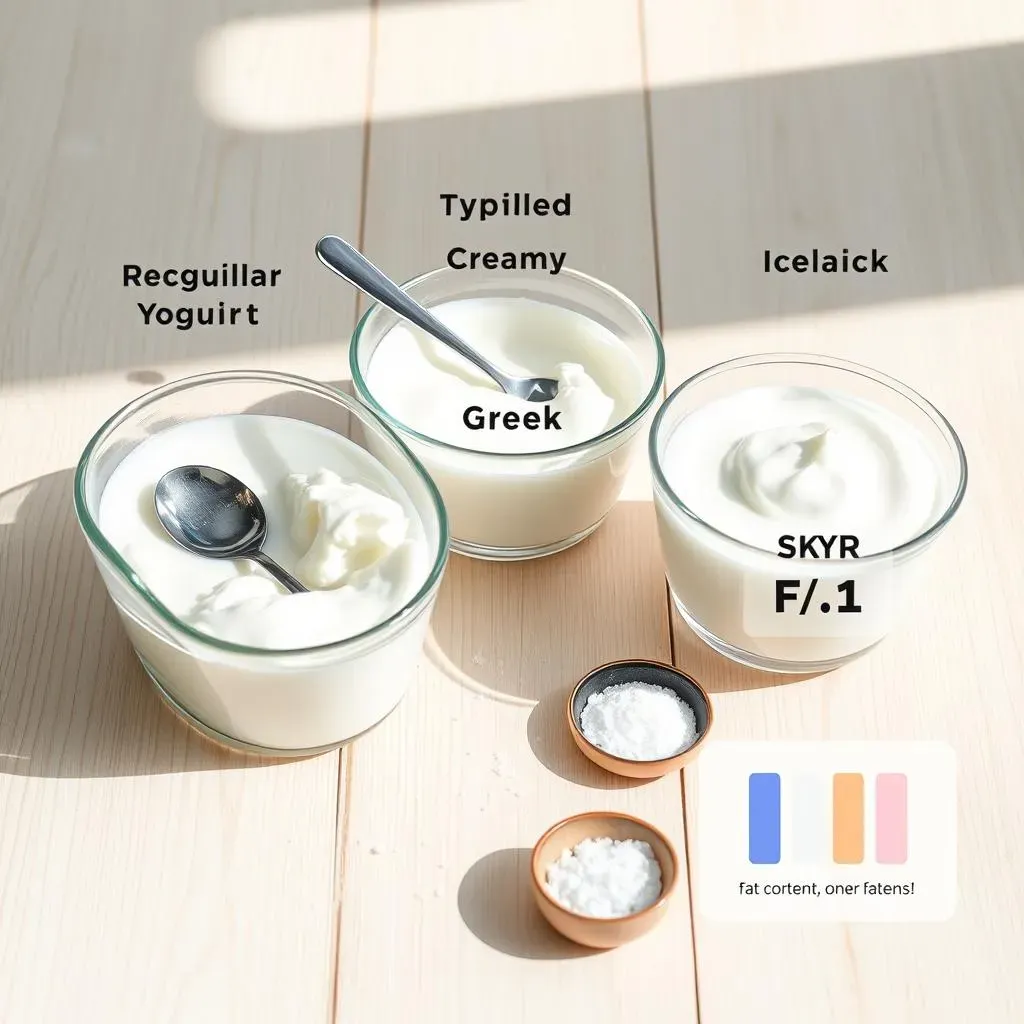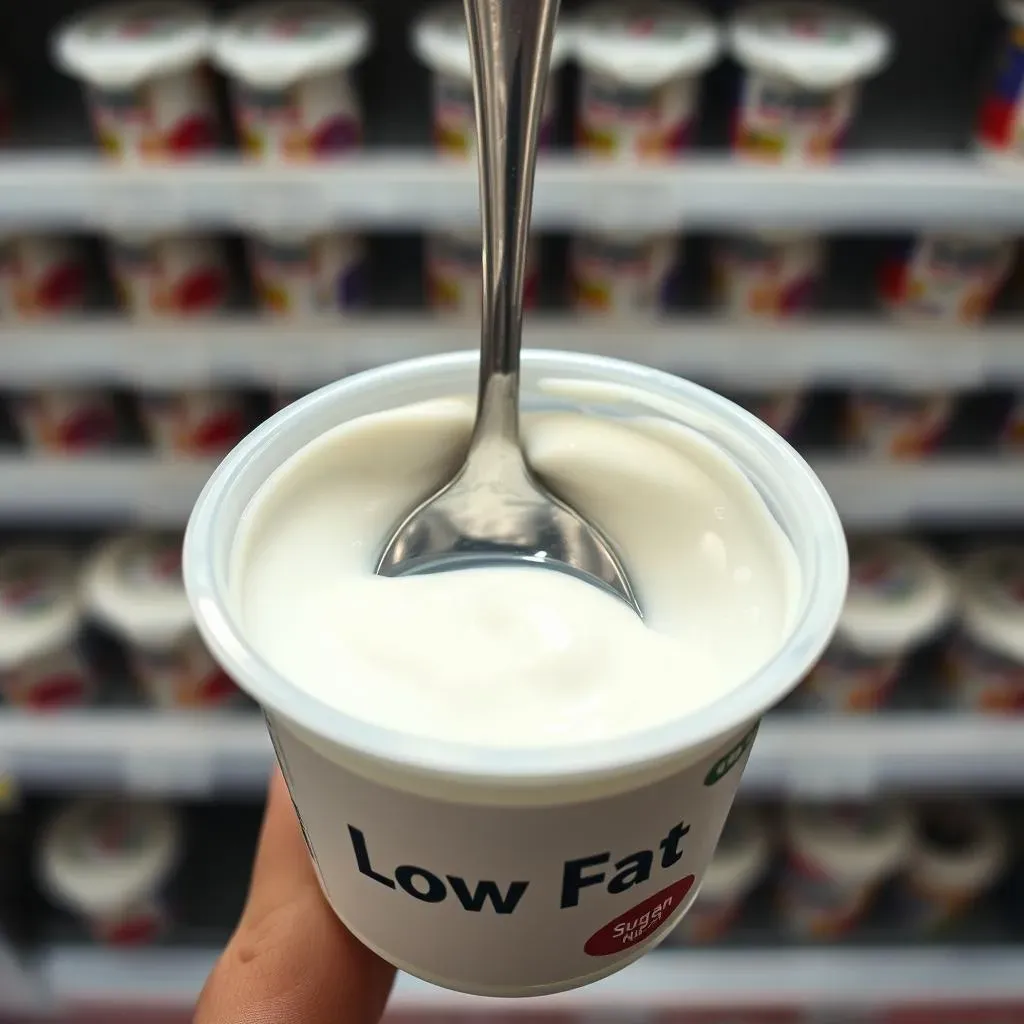Table of Contents
You're strolling through the supermarket, aiming for the "healthy" aisle. Your eyes land on low-fat yogurt, a seemingly guilt-free option. But hold on a minute, is it really all that good for you? We often choose low-fat options thinking we're making a smart move, but what if I told you some of these yogurts are secretly loaded with sugar? It's a sneaky move by food companies to make up for the lack of flavor when they remove the fat. This article will explore the truth about sugar in low fat yogurt, explaining the different types of yogurt, where those sugars are hiding, and how to make better choices. We'll break down the labels, ditch the confusion, and arm you with the knowledge to enjoy yogurt without the sugar rush. Get ready to become a yogurt pro; it's time to uncover what's really in your cup.
Understanding Different Types of Yogurt and Their Sugar Content

Understanding Different Types of Yogurt and Their Sugar Content
so you're staring down the yogurt aisle, right? It's a battlefield of brands and labels, and honestly, it’s enough to make anyone's head spin. You've got your regular yogurt, your Greek yogurt, your Icelandic Skyr – it’s like a whole new language! The main thing to remember is that they differ in how they're made, which seriously affects their texture and, yep, you guessed it, their sugar content. Regular yogurt is usually thinner, Greek yogurt is strained to make it thicker and higher in protein, and Skyr is super thick, almost like a cheese. Each one has a different level of natural sugars (from lactose, the milk sugar), and that's where it gets interesting because companies often add extra sugar, especially in the flavored versions.
It's not just about the type of yogurt; it's also about the fat content. You've got full-fat, low-fat, and non-fat options. Now, you would think that non-fat would be the healthiest, right? But often, when they take out the fat, they add more sugar to make it palatable. It's a sneaky trade-off that can catch you out. So, you might grab a low-fat yogurt thinking you're doing yourself a favor, but you could be getting more sugar than you bargained for. It’s like a magician's trick, they take away the fat and add sugar instead. So, when you are choosing your yogurt, you need to be aware of the sugar content and the fat content.
Yogurt Type | Texture | Typical Sugar Content (per cup) | Fat Content |
|---|---|---|---|
Regular Yogurt | Thinner | 10-15g (natural lactose) + added sugar | Varies, full-fat to non-fat |
Greek Yogurt | Thick, creamy | 7-10g (natural lactose) + added sugar | Varies, full-fat to non-fat |
Icelandic Skyr | Very thick | 5-8g (natural lactose) + added sugar | Varies, full-fat to non-fat |
The Hidden Sugars in LowFat Yogurt: What You Need to Know

The Hidden Sugars in LowFat Yogurt: What You Need to Know
so we've talked about the different types of yogurt, now let's get to the real sneaky stuff – those hidden sugars. You might be thinking, "I'm eating low-fat yogurt, so I'm good," but that's where they get you! Food companies often add extra sugar to low-fat yogurt to make up for the flavor that's lost when they remove the fat. It's like they're saying, "Oh, you want less fat? Here, have some sugar instead." It's a bit of a bait and switch. This added sugar isn't always obvious, and it goes by many names like high fructose corn syrup, cane sugar, or fruit juice concentrate.
The problem with these added sugars is that they're not the same as the natural sugars found in milk (lactose). Natural sugars are fine in moderation, but the added sugars can cause your blood sugar to spike and then crash, making you feel tired and hungry soon after. It's like riding a rollercoaster, but not the fun kind. Plus, eating too much added sugar can lead to weight gain and other health problems down the road. So, you really need to become a label detective and look out for these sneaky sugars. Don’t be fooled by the “low-fat” label, it doesn't always mean it's the healthier option.
To become a pro at spotting hidden sugars, you need to know what to look for on the label. The nutrition facts label will show you the total sugar content, but what you really need to check is the ingredients list. Look for any terms that end in "-ose" (like fructose, sucrose, glucose) or words like syrup, molasses, or honey. These are all forms of added sugar. The higher they are on the list, the more of it is in the yogurt. A good rule of thumb is to choose yogurts with as few ingredients as possible and avoid those with added sugars.
Hidden Sugar Name | Type of Sugar | Why It's Added |
|---|---|---|
High Fructose Corn Syrup | Processed sugar from corn | Cheap sweetener |
Cane Sugar | Refined sugar from sugar cane | Adds sweetness |
Fruit Juice Concentrate | Concentrated sugar from fruit | Perceived as "natural" |
Molasses | Byproduct of sugar production | Adds sweetness and color |
Honey | Natural sweetener made by bees | Adds sweetness and flavor |
Making Healthier Choices: Tips for Reducing Sugar Intake from Yogurt

Making Healthier Choices: Tips for Reducing Sugar Intake from Yogurt
Go Plain, It's Not Boring
so you're ready to ditch the sugar rollercoaster? The easiest way to do that is to switch to plain yogurt. I know, I know, it sounds boring, but hear me out. Plain yogurt is like a blank canvas. You get to control what goes into it. It's way better than being at the mercy of those sneaky food companies. Plus, you'll actually get to taste the real tang of yogurt, which is kind of awesome. Think of it as a culinary adventure waiting to happen. It opens up a whole new world of possibilities.
And don't worry, you won't be stuck eating bland yogurt for the rest of your life. You can add your own toppings like fresh or frozen fruits, a sprinkle of nuts, a dash of cinnamon, or even a little bit of honey (just a tiny bit!). The key is that you're in charge of the sweetness. This way, you can control the sugar content and make it taste exactly how you like it. It's like being the chef of your own yogurt creation. So, ditch the pre-sweetened stuff and embrace the plain side. It’s not as scary as it seems.
Topping Idea | Why It's Great |
|---|---|
Fresh Berries | Naturally sweet, full of antioxidants |
Sliced Banana | Adds creaminess and potassium |
Chopped Nuts | Provides healthy fats and crunch |
Dash of Cinnamon | Adds warmth and flavor |
A Tiny Drizzle of Honey | Adds sweetness, use sparingly |
Become a Label Detective
Alright, now that you're ready to embrace plain yogurt, let's talk about becoming a label detective. Even when you're buying plain yogurt, it's still important to check the ingredients list and the nutrition facts. Sometimes, companies add sneaky stuff even to plain yogurt, like thickeners or artificial sweeteners. So, be on the lookout. The goal is to choose yogurts with the shortest ingredient list. The less the ingredients, the better.
When you're reading the nutrition facts, pay close attention to the "added sugars" section. This will tell you how much sugar the company has added on top of the natural sugars from milk. Aim for yogurts with zero added sugars. It might take a bit of time to get used to reading labels, but it's a skill that will benefit you in the long run, not just with yogurt but with all the foods you eat. It’s like having a secret weapon against sneaky food companies. You'll be the Sherlock Holmes of the supermarket.
Slowly Reduce Sugar
If the idea of going completely plain is too much for you, then that is okay. You can start by slowly reducing the sugar in your yogurt. Maybe, instead of buying the super sugary flavored yogurts, you can try buying the less sugary versions. Or you can try mixing some plain yogurt with your favorite flavored yogurt. Then, gradually increase the amount of plain yogurt and decrease the flavored one. Think of it like weaning yourself off sugar. It's a process, not an overnight thing.
The key is to make small changes that you can stick with. If you try to go from zero to a hundred too fast, you're more likely to fall off the wagon. But if you take it one step at a time, you'll be more successful. Remember, it's not about being perfect, it's about making progress. So, be patient with yourself, and celebrate the small wins. You're on the right track to becoming a healthier, happier you.
Wrapping Up: Making Smart Yogurt Choices
So, there you have it. The world of low-fat yogurt isn't as simple as it seems. While it can be a good source of protein and calcium, the added sugar can quickly turn it into a less-than-ideal option. The key is to become a label detective, opting for plain varieties and sweetening them yourself with fruit or a touch of honey. Don't let the "low-fat" label fool you; being informed is your best bet for making genuinely healthy choices. Your body will thank you for it.
